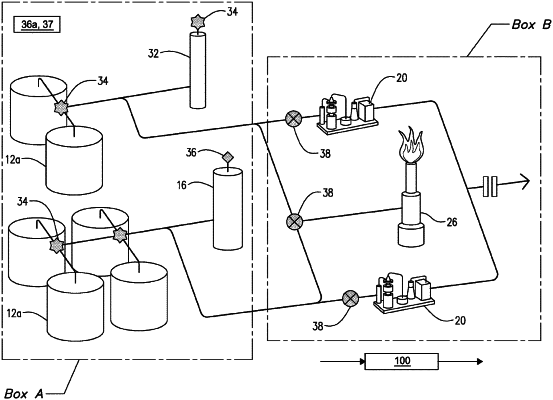| CPC G01M 3/26 (2013.01) [F17C 13/025 (2013.01); F17C 13/026 (2013.01); F17C 2205/0323 (2013.01); F17C 2221/032 (2013.01); F17C 2227/0157 (2013.01); F17C 2227/0302 (2013.01); F17C 2250/032 (2013.01); F17C 2250/043 (2013.01); F17C 2250/0439 (2013.01); F17C 2250/0443 (2013.01); F17C 2260/044 (2013.01)] | 7 Claims |

|
1. A method for identifying unwanted venting of gaseous hydrocarbons from a hydrocarbon storage system comprising the steps of:
providing a database for storage of pressure, flow rate and temperature data;
providing a central processor programmed to perform a process simulator function and mass balance operations, the process simulator function programmed to run equations of state and to receive data from said database for use in the equations of state;
providing a site-specific schematic of said hydrocarbon storage system for use by said process simulator function;
said site-specific schematic of said hydrocarbon storage system identifies at least one onsite unit selected from the group consisting of:
a compressor associated with a hydrocarbon vapor recovery line;
a flare associated with a hydrocarbon vapor recovery line;
a flare associated with a crude oil storage tank;
a flare associated with a produced water storage tank;
a storage unit containing hydrocarbon vapors;
a processing unit in said hydrocarbon storage system which produces or isolates hydrocarbon vapors;
a temperature sensor associated with a storage unit containing hydrocarbon vapors, wherein each temperature sensor provides data to said database;
a temperature sensor associated with a processing unit which produces or isolates hydrocarbon vapors, wherein each temperature sensor provides data to said database;
a flow sensor associated with conduits into and out of each storage unit containing hydrocarbon vapors, wherein each flow sensor provides data to said database;
a flow sensor associated with conduits into and out of each processing unit which produces or isolates hydrocarbon vapors, wherein each flow sensor provides data to said database;
a flow sensor associated with conduits into and out of each compressor associated with a hydrocarbon recovery line, wherein each flow sensor provides data to said database;
a flow sensor associated with conduits into and out of each compressor associated with a hydrocarbon storage tank, wherein each flow sensor provides data to said database;
a flow sensor associated with conduits into and out of each compressor associated with a hydrocarbon processing unit, wherein each flow sensor provides data to said database;
a pressure sensor associated with conduits into and out of each storage unit containing hydrocarbon vapors, wherein each pressure sensor provides data to said database;
a pressure sensor associated with conduits into and out of each processing unit which produces or isolates hydrocarbon vapors, wherein each pressure sensor provides data to said database;
receiving fluids;
identifying the received fluids in terms of relative percentages of gaseous and liquid hydrocarbons and any aqueous fluids entering the hydrocarbon storage system;
inputting the relative percentages of gaseous and liquid hydrocarbons and aqueous fluids of the received fluids into said database for use by said process simulator function;
wherein each compressor processing a total gas volume;
monitoring the total gas volume processed by each compressor using a virtual or real flow meter;
setting a user defined total error percentage for the flow sensors (TOTAL ERROR %);
using the flowrate data from each flow sensor as stored in the database, determine a total metered hydrocarbon vapor volume (TVM) handled by the hydrocarbon storage system;
using the process simulator function to run the equations of state, compute the Process Simulator Rate in terms of volume handled by the hydrocarbon storage system where the Process Simulator Rate volume of the hydrocarbon storage system equals the total estimated volume of vapors flashing on site from any tanks or vessels producing or storing any liquid hydrocarbon that could change to gas and be fed to into a vapor recovery system;
performing mass balance operations to compute a total vent volume of all storage and processing units in the hydrocarbon storage system where the total vent volume is Process Simulator Rate (PSR) −TVM±TOTAL ERROR %;
determining if unwanted venting of gaseous hydrocarbons has occurred where unwanted venting is indicated when the total vent volume is greater than zero.
|